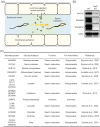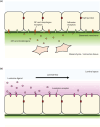Lumicrine signaling: Extracellular regulation of sperm maturation in the male reproductive tract lumen
- PMID: 37696504
- PMCID: PMC11447831
- DOI: 10.1111/gtc.13066
Lumicrine signaling: Extracellular regulation of sperm maturation in the male reproductive tract lumen
Abstract
The behaviors of cells, tissues, and organs are controlled by the extracellular environment in addition to their autonomous regulatory system. Dysfunction of extracellular regulatory mechanisms affects not only the development and survival of organisms but also successful reproduction. In this review article, a novel extracellular regulatory mechanism regulating the mammalian male reproductive ability will be briefly summarized. In terrestrial vertebrates, spermatozoa generated in the testis are transported through the lumen of the male reproductive tract and become functionally mature during the transport. Recent studies with gene-modified animals are unveiling the luminal extracellular environment of the reproductive tract to function not only as the pathway of sperm transport and the site of sperm maturation but also as the channel for cellular communication to regulate sperm maturation. Of special interest is the molecular mechanism of lumicrine signaling, a transluminal secreted signal transduction in the male reproductive tract lumen as a master regulator of sperm maturation and male reproductive ability. The general significance of such transluminal signaling in the context of cell biology will also be discussed.
Keywords: Lumicrine; NELL2; epididymis; signal transduction; sperm maturation.
© 2023 The Author. Genes to Cells published by Molecular Biology Society of Japan and John Wiley & Sons Australia, Ltd.
Conflict of interest statement
The authors declare no conflicts of interest.
Figures



Similar articles
-
Expression of NELL2/NICOL-ROS1 lumicrine signaling-related molecules in the human male reproductive tract.Reprod Biol Endocrinol. 2024 Jan 2;22(1):3. doi: 10.1186/s12958-023-01175-6. Reprod Biol Endocrinol. 2024. PMID: 38169386 Free PMC article.
-
The molecular mechanisms of mammalian sperm maturation regulated by NELL2-ROS1 lumicrine signaling.J Biochem. 2022 Dec 5;172(6):341-346. doi: 10.1093/jb/mvac071. J Biochem. 2022. PMID: 36071564 Review.
-
A small secreted protein NICOL regulates lumicrine-mediated sperm maturation and male fertility.Nat Commun. 2023 Apr 24;14(1):2354. doi: 10.1038/s41467-023-37984-x. Nat Commun. 2023. PMID: 37095084 Free PMC article.
-
Adhesion G protein-coupled receptor G2 is dispensable for lumicrine signaling regulating epididymal initial segment differentiation and gene expression†.Biol Reprod. 2023 Oct 13;109(4):474-481. doi: 10.1093/biolre/ioad087. Biol Reprod. 2023. PMID: 37531264 Free PMC article.
-
The Role of the Epididymis and the Contribution of Epididymosomes to Mammalian Reproduction.Int J Mol Sci. 2020 Jul 29;21(15):5377. doi: 10.3390/ijms21155377. Int J Mol Sci. 2020. PMID: 32751076 Free PMC article. Review.
Cited by
-
Expression of NELL2/NICOL-ROS1 lumicrine signaling-related molecules in the human male reproductive tract.Reprod Biol Endocrinol. 2024 Jan 2;22(1):3. doi: 10.1186/s12958-023-01175-6. Reprod Biol Endocrinol. 2024. PMID: 38169386 Free PMC article.
-
Chemical Synthesis of NICOL, A Coligand Secreted Protein Mediating Mammalian Male Reproductive Tract Trans-luminal Signaling.Chemistry. 2025 Aug 21;31(47):e01588. doi: 10.1002/chem.202501588. Epub 2025 Jul 26. Chemistry. 2025. PMID: 40713872 Free PMC article.
-
Distinct actions of testicular endocrine and lumicrine signaling on the proximal epididymal transcriptome.Reprod Biol Endocrinol. 2024 Apr 10;22(1):40. doi: 10.1186/s12958-024-01213-x. Reprod Biol Endocrinol. 2024. PMID: 38600586 Free PMC article.
-
Busulfan administration replicated the characteristics of the epididymal initial segment observed in mice lacking testis-epididymis lumicrine signaling.J Reprod Dev. 2024 Apr 4;70(2):104-114. doi: 10.1262/jrd.2023-102. Epub 2024 Feb 9. J Reprod Dev. 2024. PMID: 38346723 Free PMC article.
References
-
- Da Ros, V. G. , Maldera, J. A. , Willis, W. D. , Cohen, D. J. , Goulding, E. H. , Gelman, D. M. , Rubinstein, M. , Eddy, E. M. , & Cuasnicu, P. S. (2008). Impaired sperm fertilizing ability in mice lacking Cysteine‐RIch Secretory Protein 1 (CRISP1). Developmental Biology, 320, 12–18. 10.1016/j.ydbio.2008.03.015 - DOI - PMC - PubMed
Publication types
MeSH terms
Grants and funding
LinkOut - more resources
Full Text Sources

